coolant temperature DODGE VIPER 2008 ZB II / 2.G Owners Manual
[x] Cancel search | Manufacturer: DODGE, Model Year: 2008, Model line: VIPER, Model: DODGE VIPER 2008 ZB II / 2.GPages: 303, PDF Size: 2.65 MB
Page 96 of 303
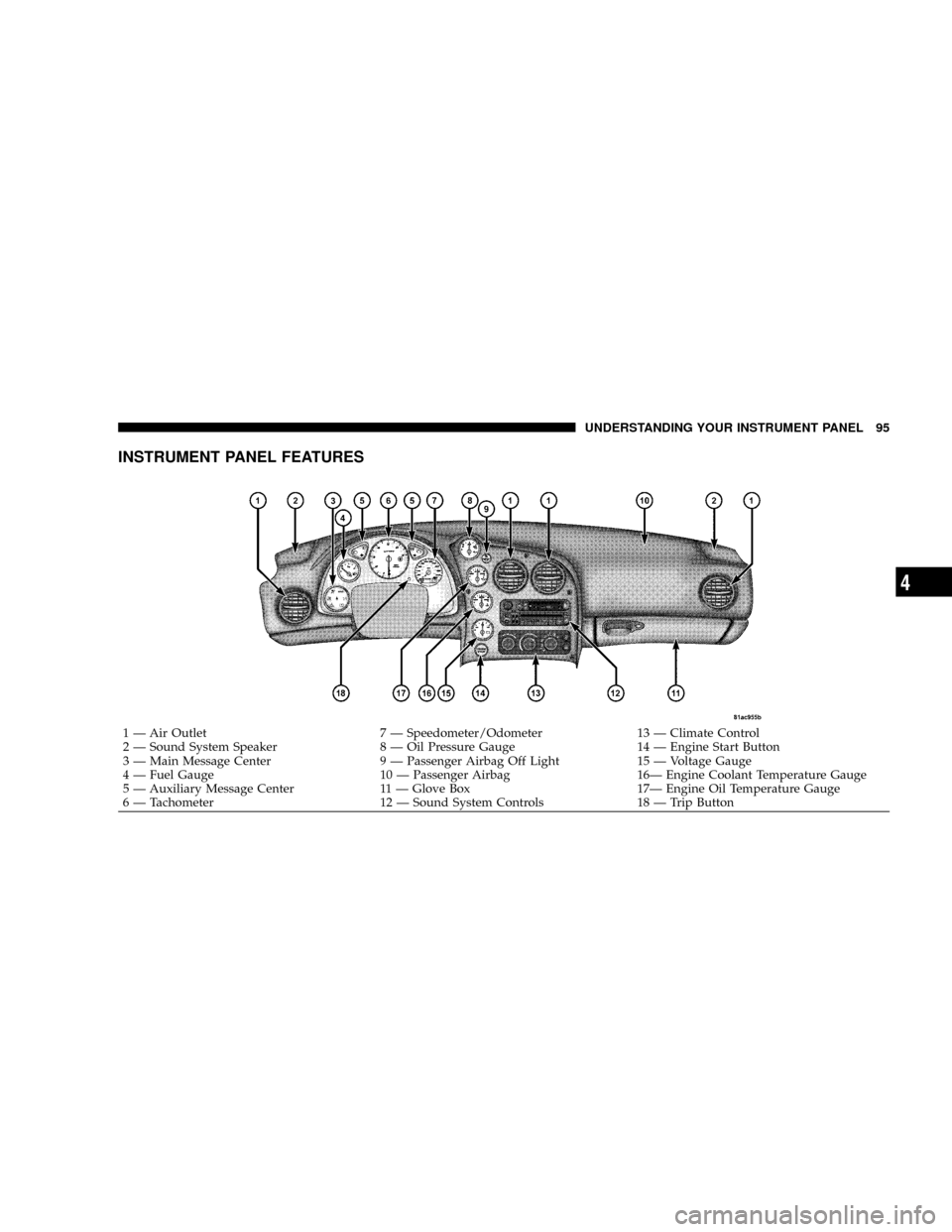
INSTRUMENT PANEL FEATURES
1 Ð Air Outlet 7 Ð Speedometer/Odometer 13 Ð Climate Control
2 Ð Sound System Speaker 8 Ð Oil Pressure Gauge 14 Ð Engine Start Button
3 Ð Main Message Center 9 Ð Passenger Airbag Off Light 15 Ð Voltage Gauge
4 Ð Fuel Gauge 10 Ð Passenger Airbag 16Ð Engine Coolant Temperature Gauge
5 Ð Auxiliary Message Center 11 Ð Glove Box 17Ð Engine Oil Temperature Gauge
6 Ð Tachometer 12 Ð Sound System Controls 18 Ð Trip ButtonUNDERSTANDING YOUR INSTRUMENT PANEL 95
4
Page 105 of 303
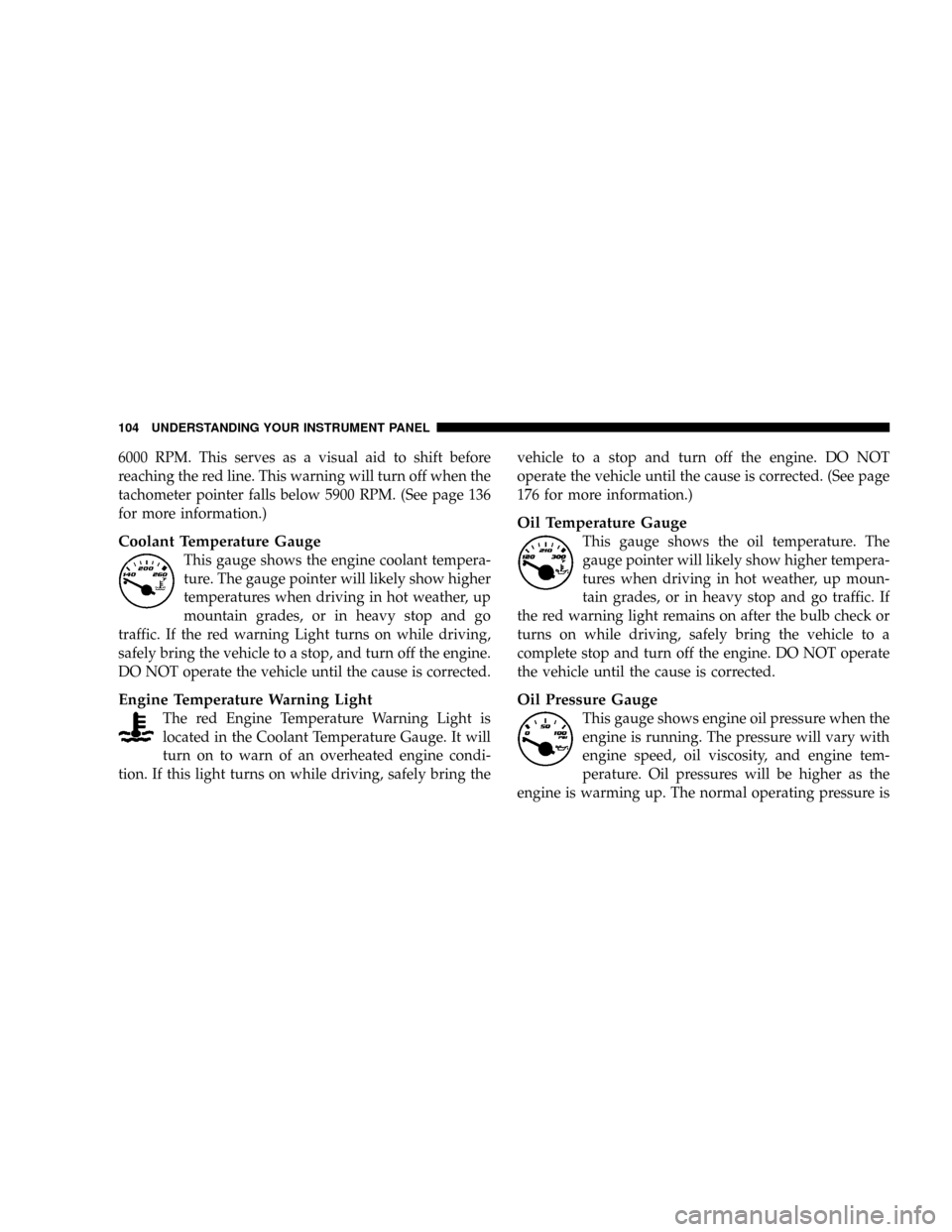
6000 RPM. This serves as a visual aid to shift before
reaching the red line. This warning will turn off when the
tachometer pointer falls below 5900 RPM. (See page 136
for more information.)
Coolant Temperature Gauge
This gauge shows the engine coolant tempera-
ture. The gauge pointer will likely show higher
temperatures when driving in hot weather, up
mountain grades, or in heavy stop and go
traffic. If the red warning Light turns on while driving,
safely bring the vehicle to a stop, and turn off the engine.
DO NOT operate the vehicle until the cause is corrected.
Engine Temperature Warning Light
The red Engine Temperature Warning Light is
located in the Coolant Temperature Gauge. It will
turn on to warn of an overheated engine condi-
tion. If this light turns on while driving, safely bring thevehicle to a stop and turn off the engine. DO NOT
operate the vehicle until the cause is corrected. (See page
176 for more information.)
Oil Temperature Gauge
This gauge shows the oil temperature. The
gauge pointer will likely show higher tempera-
tures when driving in hot weather, up moun-
tain grades, or in heavy stop and go traffic. If
the red warning light remains on after the bulb check or
turns on while driving, safely bring the vehicle to a
complete stop and turn off the engine. DO NOT operate
the vehicle until the cause is corrected.
Oil Pressure Gauge
This gauge shows engine oil pressure when the
engine is running. The pressure will vary with
engine speed, oil viscosity, and engine tem-
perature. Oil pressures will be higher as the
engine is warming up. The normal operating pressure is
104 UNDERSTANDING YOUR INSTRUMENT PANEL
Page 178 of 303
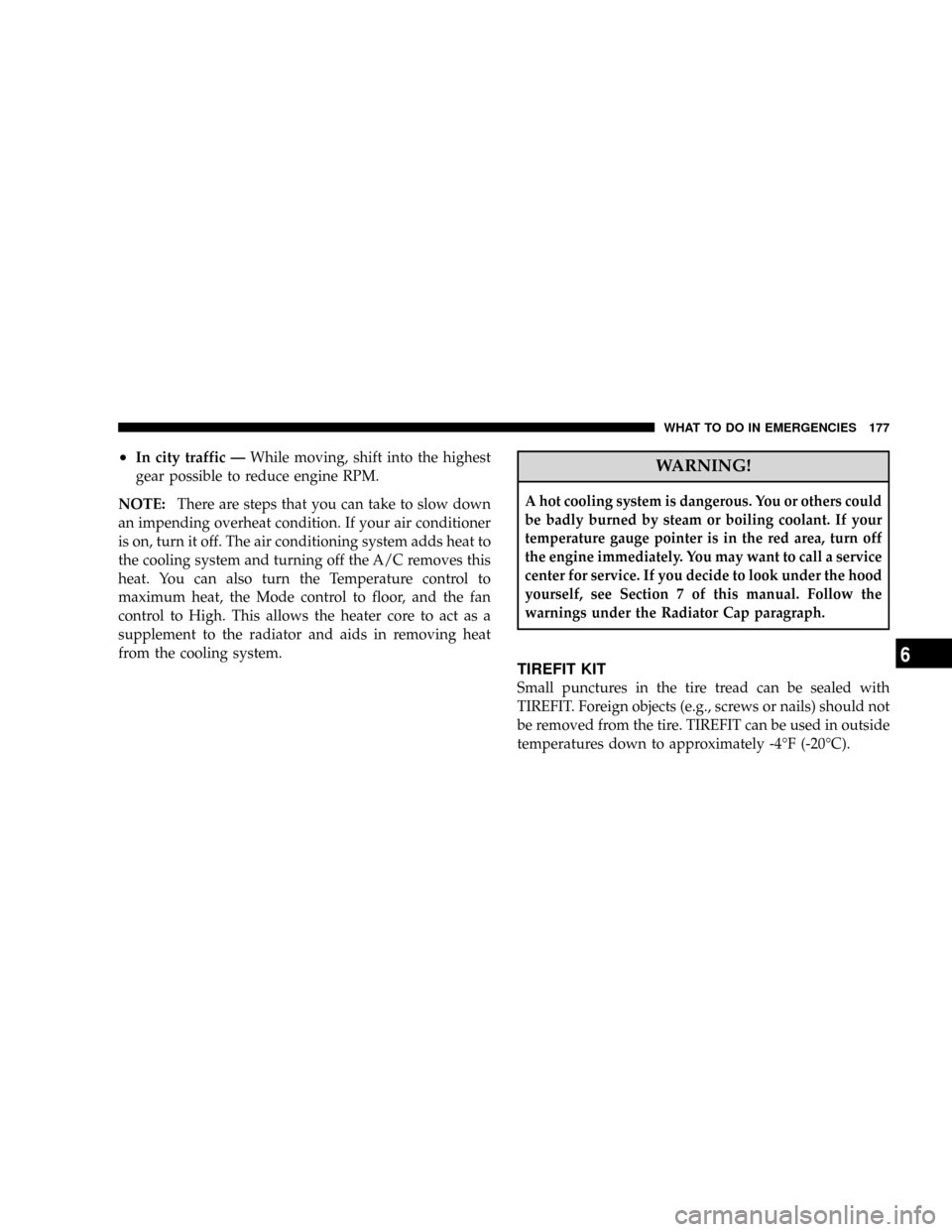
²In city traffic ÐWhile moving, shift into the highest
gear possible to reduce engine RPM.
NOTE:There are steps that you can take to slow down
an impending overheat condition. If your air conditioner
is on, turn it off. The air conditioning system adds heat to
the cooling system and turning off the A/C removes this
heat. You can also turn the Temperature control to
maximum heat, the Mode control to floor, and the fan
control to High. This allows the heater core to act as a
supplement to the radiator and aids in removing heat
from the cooling system.WARNING!
A hot cooling system is dangerous. You or others could
be badly burned by steam or boiling coolant. If your
temperature gauge pointer is in the red area, turn off
the engine immediately. You may want to call a service
center for service. If you decide to look under the hood
yourself, see Section 7 of this manual. Follow the
warnings under the Radiator Cap paragraph.
TIREFIT KIT
Small punctures in the tire tread can be sealed with
TIREFIT. Foreign objects (e.g., screws or nails) should not
be removed from the tire. TIREFIT can be used in outside
temperatures down to approximately -4ÉF (-20ÉC).
WHAT TO DO IN EMERGENCIES 177
6
Page 220 of 303

Cooling System
WARNING!
²When working near the radiator cooling fans,
disconnect each fan motor lead or turn the ignition
switch to the OFF position. The fans are tempera-
ture controlled and can start any time the ignition
switch is in the ON position.
²You or others can be badly burned by hot coolant
or steam from your radiator. If you see or hear
steam coming from under the hood, don't open the
hood until the radiator has had time to cool. Never
try to open a cooling system pressure cap when the
radiator is hot.
Coolant Checks
Check engine coolant (antifreeze) protection every 12
months (before the onset of freezing weather, where
applicable). If coolant is dirty or rusty in appearance, the
system should be drained, flushed, and refilled with
fresh coolant. Check the front of the A/C condenser/
radiator for any accumulation of bugs, leaves, etc. If dirty,
clean by gently spraying water from a garden hose
vertically down the face of the condenser/radiator.
Check the coolant recovery bottle tubing for brittle rub-
ber, cracking, tears, cuts, and tightness of the connection
at the bottle and radiator. Inspect the entire system for
leaks.
With the engine at normal operating temperature (but
not running), check the cooling system pressure cap for
proper vacuum sealing by draining a small amount of
coolant from the radiator drain cock. If the cap is sealing
properly, the engine coolant (antifreeze) will begin to
MAINTAINING YOUR VEHICLE 219
7
Page 222 of 303
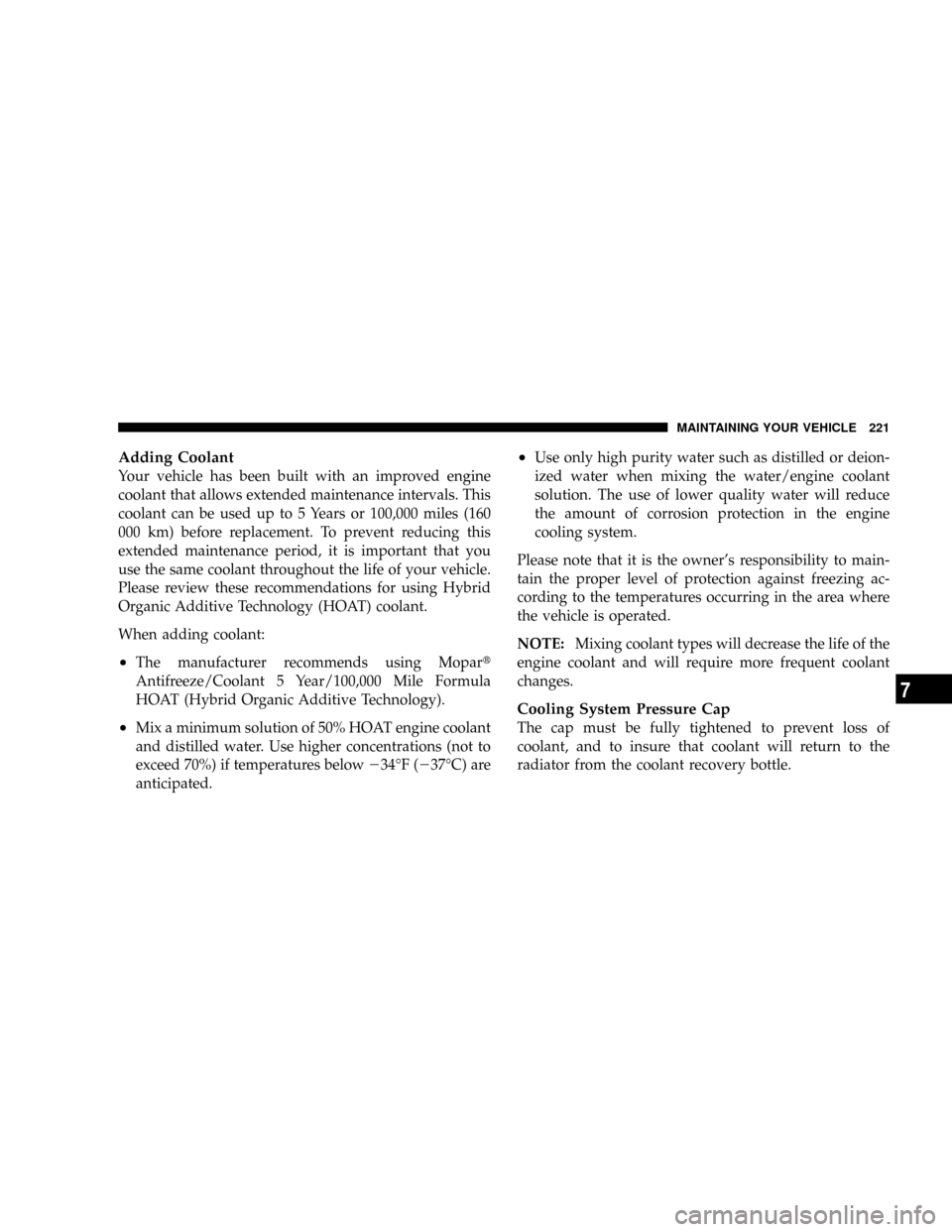
Adding Coolant
Your vehicle has been built with an improved engine
coolant that allows extended maintenance intervals. This
coolant can be used up to 5 Years or 100,000 miles (160
000 km) before replacement. To prevent reducing this
extended maintenance period, it is important that you
use the same coolant throughout the life of your vehicle.
Please review these recommendations for using Hybrid
Organic Additive Technology (HOAT) coolant.
When adding coolant:
²The manufacturer recommends using Mopart
Antifreeze/Coolant 5 Year/100,000 Mile Formula
HOAT (Hybrid Organic Additive Technology).
²Mix a minimum solution of 50% HOAT engine coolant
and distilled water. Use higher concentrations (not to
exceed 70%) if temperatures below234ÉF (237ÉC) are
anticipated.
²Use only high purity water such as distilled or deion-
ized water when mixing the water/engine coolant
solution. The use of lower quality water will reduce
the amount of corrosion protection in the engine
cooling system.
Please note that it is the owner's responsibility to main-
tain the proper level of protection against freezing ac-
cording to the temperatures occurring in the area where
the vehicle is operated.
NOTE:Mixing coolant types will decrease the life of the
engine coolant and will require more frequent coolant
changes.
Cooling System Pressure Cap
The cap must be fully tightened to prevent loss of
coolant, and to insure that coolant will return to the
radiator from the coolant recovery bottle.
MAINTAINING YOUR VEHICLE 221
7
Page 224 of 303

service attendant of this. As long as the engine operating
temperature is satisfactory, the coolant bottle need only
be checked once a month.
When additional coolant is needed to maintain the
proper level, it should be added to the coolant bottle. Do
not overfill.
Points to Remember
NOTE:When the vehicle is stopped after a few miles (a
few kilometers) of operation, you may observe vapor
coming from the front of the engine compartment. This is
normally a result of moisture from rain, snow, or high
humidity accumulating on the radiator and being vapor-
ized when the thermostat opens, allowing hot coolant to
enter the radiator.
If an examination of your engine compartment shows no
evidence of radiator or hose leaks, the vehicle may be
safely driven. The vapor will soon dissipate.
²Do not overfill the coolant recovery bottle.
²Check coolant freeze point in the coolant bottle. If
antifreeze needs to be added, contents of the coolant
bottle also must be protected against freezing.
²If frequent coolant additions are required, or if the
level in the coolant recovery bottle does not drop when
the engine cools, the cooling system should be pres-
sure tested for leaks.
²Maintain coolant concentration at 50% HOAT engine
coolant (minimum) and distilled water for proper
corrosion protection of your engine, which contains
aluminum components.
²Make sure that the radiator and coolant recovery
bottle overflow hoses are not kinked or obstructed.
²Keep the front of the radiator clean. If your vehicle is
equipped with air conditioning, keep the front of the
condenser clean, also.
MAINTAINING YOUR VEHICLE 223
7
Page 260 of 303

SCHEDULE ªBº
Follow schedule ªBº if you usually operate your vehicle
under one or more of the following conditions.
²Day or night temperatures are below 32É F (0É C).
²Stop and go driving.
²Extensive engine idling.
²Driving in dusty conditions.
²Short trips of less than 10 miles (16 km).
²More than 50% of your driving is at sustained high
speeds during hot weather, above 90É F (32É C).
²Trailer towing.
²Taxi, police, or delivery service (commercial service).
²Off-road or desert operation.
²If equipped for and operating with E-85 (ethanol)
fuel.
NOTE:IfANYof these apply to you, then change your
engine oil every 3,000 miles (5000 km) or 3 months,
whichever comes first, and follow the maintenance rec-
ommendations in Schedule ªBº in this section.
NOTE:IfANYof these apply to you, then flush and
replace the engine coolant every 102,000 miles (170 000
km) or 60 months, whichever comes first, and follow the
maintenance recommendations in Schedule ªBº in this
section.
SCHEDULE ªBº 259
8
M
A
I
N
T
E
N
A
N
C
E
S
C
H
E
D
U
L
E
S
Page 292 of 303
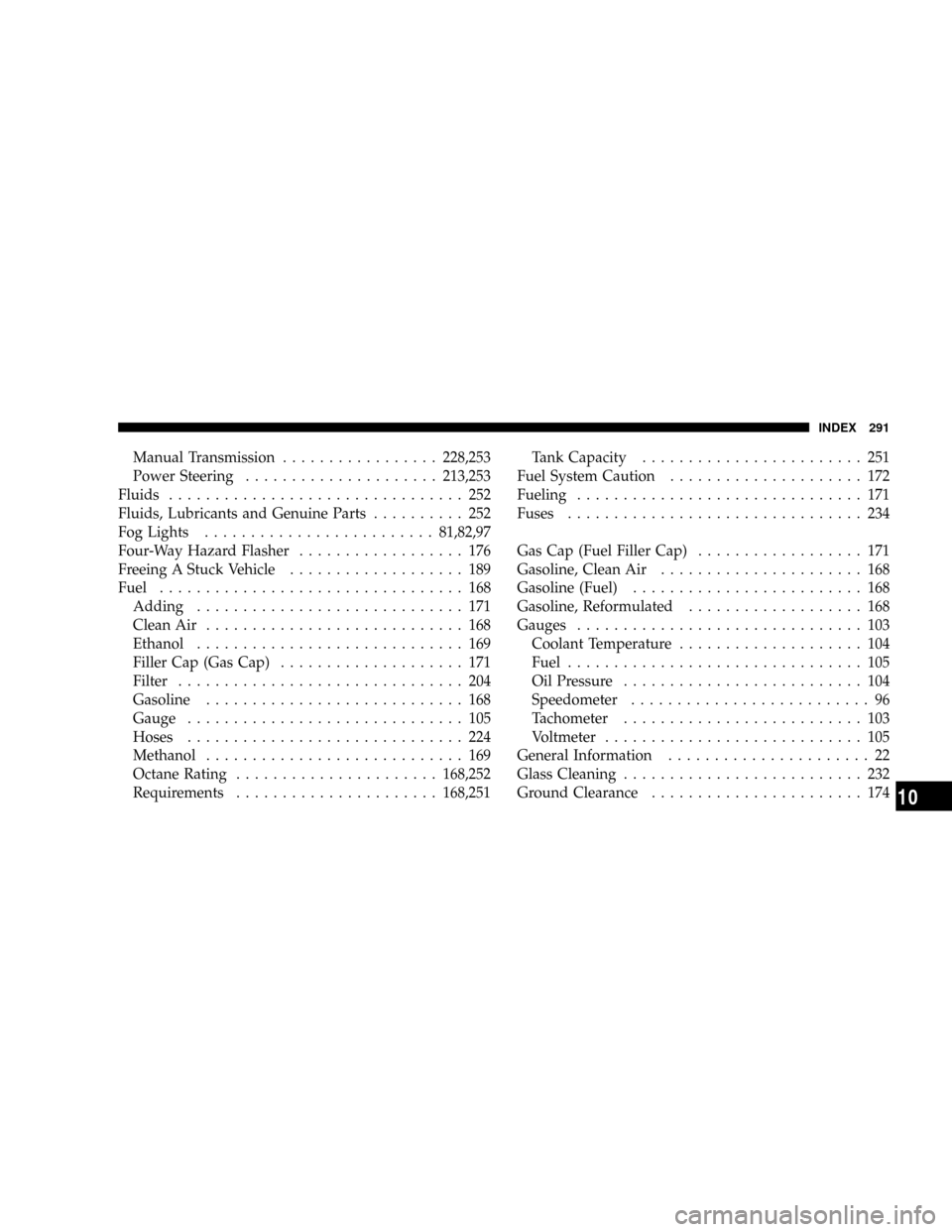
Manual Transmission.................228,253
Power Steering.....................213,253
Fluids................................ 252
Fluids, Lubricants and Genuine Parts.......... 252
Fog Lights.........................81,82,97
Four-Way Hazard Flasher.................. 176
Freeing A Stuck Vehicle................... 189
Fuel................................. 168
Adding............................. 171
Clean Air............................ 168
Ethanol............................. 169
Filler Cap (Gas Cap).................... 171
Filter............................... 204
Gasoline............................ 168
Gauge.............................. 105
Hoses.............................. 224
Methanol............................ 169
Octane Rating......................168,252
Requirements......................168,251Tank Capacity........................ 251
Fuel System Caution..................... 172
Fueling............................... 171
Fuses................................ 234
Gas Cap (Fuel Filler Cap).................. 171
Gasoline, Clean Air...................... 168
Gasoline (Fuel)......................... 168
Gasoline, Reformulated................... 168
Gauges............................... 103
Coolant Temperature.................... 104
Fuel................................ 105
Oil Pressure.......................... 104
Speedometer.......................... 96
Tachometer.......................... 103
Voltmeter............................ 105
General Information...................... 22
Glass Cleaning.......................... 232
Ground Clearance....................... 174
INDEX 291
10
Page 299 of 303

Service Contract......................... 279
Service Engine Soon Light
(Malfunction Indicator).................... 98
Service Manuals........................ 282
Setting the Clock........................ 106
Shift Indicator Light...................103,138
Shift Speeds.........................136,138
Shift Speeds, Manual Transaxle.............. 138
Shoulder Belts........................... 31
Signals, Turn..........................82,99
Six Point Belt System...................... 38
Slippery Surfaces, Driving On............... 139
Snow Chains (Tire Chains)................. 164
Snow Tires............................ 164
Spark Plugs............................ 203
Speedometer............................ 96
Starting............................... 132
Emergency (Jump Starting)............... 186
Engine Fails to Start.................... 135Starting and Operating.................... 132
Starting Procedures...................... 132
Steering
Linkage............................. 214
Power...........................148,213
Tilt Column........................... 89
Storage............................... 238
Storage, Vehicle......................... 126
Stuck, Freeing.......................... 189
Supplemental Restraint System - Airbag........ 40
Tachometer............................ 103
Temperature Gauge, Engine Coolant.......... 104
Theft Alarm (Security Alarm)................ 13
Theft System (Security Alarm)............... 13
Tilt Steering Column...................... 89
Tire and Loading Information Placard......... 153
Tire Identification Number (TIN)............. 152
Tire Markings.......................... 149
298 INDEX